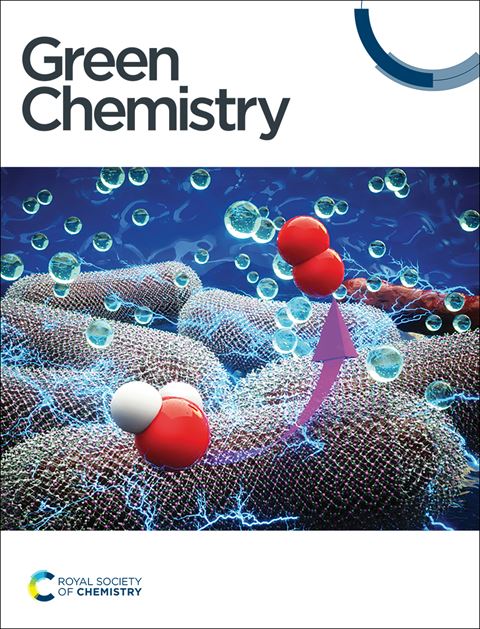Tailored mechanical properties of soybean oil-based non-isocyanate polyurethanes by copolymer integration†
IF 9.3
1区 化学
Q1 CHEMISTRY, MULTIDISCIPLINARY
引用次数: 0
Abstract
Stiff thermoset polyurethane (PU) plays a crucial role in high-performance applications, particularly in industries requiring exceptional mechanical integrity, chemical resistance, and thermal stability. To reduce the environmental impact of PU production, (i) soybean oil has emerged as a renewable and abundant alternative to petroleum-based feedstocks, offering biodegradability and a reduced carbon footprint, while (ii) non-isocyanate polyurethane (NIPU) provides a greener approach by eliminating hazardous isocyanate compounds and avoiding isocyanate-functionalized chemicals. However, the development of soybean oil-based NIPU faces challenges in achieving the desired stiffness and resistance against fracture due to the large molecular size and inconsistent structure of soybean oil, which result in low crosslinking density and a lack of short-range ordering. To address the limitations of soybean oil-based NIPU, we developed a method that restricts polymer network relaxation by incorporating short-range ordered polymer segments using a copolymer with ethyl methacrylate (EMA) segments. Surpassing the highest mechanical properties reported for soybean oil-based NIPU to date, co-NIPU-x derived from copolymers with higher EMA content exhibits improved mechanical properties, demonstrating a four-fold increase in Young's modulus and a two-fold increase in tensile stress. The adjustable poly(2-aminoethylmethacrylate-ran-ethylmethacryate) (poly(AEMA-ran-EMA)) composition ratio allows for a wide range of mechanical properties, with Young's modulus ranging from 60 to 1030 MPa and tensile stress from 2.1 to 25 MPa. Furthermore, these NIPU samples exhibited enhanced adhesion properties with lap shear strength exceeding 7 MPa, significantly higher than those of traditional formulations. The thermal stability was improved with the NIPU samples resisting structural degradation, and chemical resistance was confirmed by sufficient swelling ratios in both hydrophilic and hydrophobic solvents, underscoring their suitability for a broader range of industrial applications.

硬质热固性聚氨酯(PU)在高性能应用中发挥着至关重要的作用,尤其是在需要优异机械完整性、耐化学性和热稳定性的行业中。为了减少聚氨酯生产对环境的影响,(i) 大豆油已成为石油基原料的一种可再生且丰富的替代品,具有生物降解性并可减少碳足迹;(ii) 非异氰酸酯聚氨酯 (NIPU) 通过消除有害的异氰酸酯化合物和避免使用异氰酸酯功能化化学品,提供了一种更环保的方法。然而,由于大豆油的分子尺寸大且结构不一致,导致交联密度低且缺乏短程有序性,因此开发基于大豆油的 NIPU 在实现理想的刚度和抗断裂性方面面临挑战。为了解决大豆油基 NIPU 的局限性,我们开发了一种方法,利用甲基丙烯酸乙酯(EMA)段共聚物加入短程有序聚合物段,从而限制聚合物网络松弛。由 EMA 含量较高的共聚物制成的共 NIPU-x 具有更好的机械性能,杨氏模量提高了四倍,拉伸应力提高了两倍,超过了迄今为止所报道的豆油基 NIPU 的最高机械性能。可调节的聚(2-氨基乙基甲基丙烯酸酯-ran-乙基甲基丙烯酸酯)(聚(AEMA-ran-EMA))成分比可实现广泛的机械性能,杨氏模量范围为 60 至 1030 兆帕,拉伸应力范围为 2.1 至 25 兆帕。此外,这些 NIPU 样品还具有更强的粘附性能,搭接剪切强度超过 7 兆帕,明显高于传统配方。NIPU 样品的热稳定性得到了改善,结构不易降解,在亲水和疏水溶剂中都有足够的溶胀率,这证实了它们的耐化学性,适合更广泛的工业应用。
本文章由计算机程序翻译,如有差异,请以英文原文为准。
求助全文
约1分钟内获得全文
求助全文
来源期刊

Green Chemistry
化学-化学综合
CiteScore
16.10
自引率
7.10%
发文量
677
审稿时长
1.4 months
期刊介绍:
Green Chemistry is a journal that provides a unique forum for the publication of innovative research on the development of alternative green and sustainable technologies. The scope of Green Chemistry is based on the definition proposed by Anastas and Warner (Green Chemistry: Theory and Practice, P T Anastas and J C Warner, Oxford University Press, Oxford, 1998), which defines green chemistry as the utilisation of a set of principles that reduces or eliminates the use or generation of hazardous substances in the design, manufacture and application of chemical products. Green Chemistry aims to reduce the environmental impact of the chemical enterprise by developing a technology base that is inherently non-toxic to living things and the environment. The journal welcomes submissions on all aspects of research relating to this endeavor and publishes original and significant cutting-edge research that is likely to be of wide general appeal. For a work to be published, it must present a significant advance in green chemistry, including a comparison with existing methods and a demonstration of advantages over those methods.
 求助内容:
求助内容: 应助结果提醒方式:
应助结果提醒方式:


